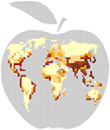Sofia
 “Grows, but does not age”
“Grows, but does not age”
Sofia is one of the most ancient European capitals. It is assumed that its history dates back to around the VIII century BC, when the city occurs around the termal springs. In the past Sofia is known also as “Serdika”, “Ulpia Serdika”, “Sredetz”, and “Triaditsa” It is believed that the modern name of Sofia cames from the name of St. Sophia church. A glimpse of old history of the capital city you can take at this website.
“Serdika is my Rome” –
Constantine the Great (272-337)
Situated on one of the most ancient and brisk roads in Europe, linking the West and the East, through the centuries the town has drawn the attention of different cultures and civilizations, who have left priceless evidences of their upsurge and downfall.
Sofia was declared capital in 1879. It was then the fifth-largest city in the country after Plovdiv, Varna, Ruse and Shumen. Today Sofia is the largest city in Bulgaria.
Sofia in Figures
| Population as of 31.12.2012 | 1 301 683 | Museums | 27 | |
|---|---|---|---|---|
| Population density per km2 | 1013,1 | Theaters | 23 | |
| Geographic Coordinates | 42°42'N 23°20'E | Art galleries | 37 | |
| Area (municipality) in km2 | 1284,9 | Universities | 16 | |
| Average Altitude | 550 m | Schools | 297 | |
| Mineral Springs | over 30 | Kindergartens | 235 |
Discover Sofia
Churches and religious temples
St. Alexander Nevski Cathedral – the largest on the Balkan Peninsula.
St. Georgi Rotunda – the oldest building in Sofia and oldest functioning church in Europe, included in UNESCO's World Heritage list.
St. Sofia Church – the second oldest churche in Sofia, which gave its name to the city.
Boyana Church – beautifully preserved monument of Bulgarian medieval art with over 240 murals, also enters in UNESCO's World Heritage list.
Sofia Synagogue – the third largest in Europe.
Russian Church “St. Nikolay” is one of Sofia's most attractive photo targets.
Banya Bashi Mosque – built in 16th century by the most famous Ottoman architect Mimar Sinan, is the only functioning mosque in Sofia.
Museums and Galleries
National Historical Museum – one of the largest historical museums on the Balkans.
Archeological National Museum – the oldest museum in the country and one of the largest in Europe.
Ethnographic Museum with over 50,000 artifacts.
National Art Gallery – with over 3,000 artworks by famous Bulgarian artists.
Sofia City Art Gallery contains some of the richest collections of Bulgarian art.
National Gallery for Foreign Art – with one of the biggest collection of Indian Art in Europe.
Emblematic Places
The Ivan Vazov National Theatre – an institution with 100 years of history.
The National Palace of Culture (NDK) – one of the symbols of the Capital.
Grean Areas
Sofia is surrounded by five mountains – Vitosha, Lyulin, Plana, Lozenska and Stara Planina.
Vitosha National Park – Vitosha is the oldest park in both Bulgaria and the Balkan peninsula. It was established one year after the London declaration of national parks.
Sofia has an extensive green belt. There are four principal parks – Borisova gradina in the city centre and the Southern, Western and Northern park and several other smaller parks – The City Garden and The Doctors' Garden, located in central Sofia.


